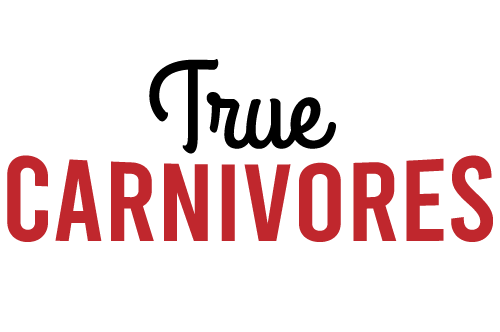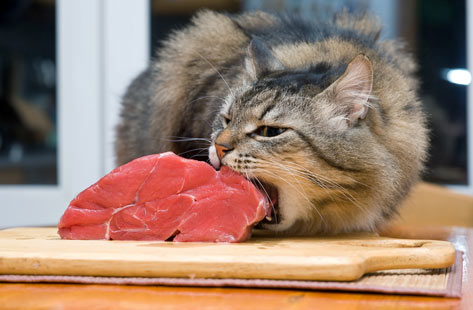Obligate Carnivores: Nature’s True Carnivores.
Very simply, carnivores are animals whose diet consists mainly or entirely of animal tissue. Because animals evolved to eat the diet which is healthiest for them, and carnivores are no different. Over millions of years, carnivores have developed traits which optimize their ability to find and consume meat.
So what makes a carnivore, a carnivore?
Some specific traits include:
- Short, simple digestive tract: not equipped to break down the tough cell walls of plants.
- Eyes on the front of their head: increased depth perception for hunting.
- Strong, wide-opening jaws which cannot move side to side: to capture prey and tear flesh.
- Pointed teeth that do not line up with each other: to rip meat. Little to no ability to grind plant-material.
- Lack of amylase in saliva: an enzyme found in the mouths of herbivores and omnivores to begin the breakdown of plant cells while chewing.
The many kinds of Carnivores
Not all carnivores are created equal. Aside from a requirement of meat in the diet, there are many specific requirements which are often unique to their species. Dogs and wolves are known as facultative carnivores. A facultative carnivore does best on a carnivorous diet, but can survive, not thrive on a non-carnivorous one. An omnivore really doesn’t care much either way. It eats what’s available, vegetable or meat. All members of the Felidae family: lions, tigers, leopards etc., and the domestic housecat (who shares 95% of their DNA with the Siberian Tiger!), are known as obligate carnivores.
Obligate Carnivores in-depth
An obligate carnivore (or true carnivore) is an animal that must eat meat in order to survive. Cats meet their blood sugar requirements by breaking down protein, rather than carbohydrates in their diet. They are so dependent on protein that if their diet is lacking enough protein to supply their energy needs, they will break down their own body muscle and organs. True carnivores lack the digestive system features required for the efficient digestion of plant material. In fact, some carnivorous mammals will eat vegetation specifically to vomit.
Cat’s digestion and nutritional needs
Domestic cats evolved from a desert-dwelling species found in Northern Africa and the Arabian Peninsula. This region would not have allowed wild cats much access to vegetation. This explains why their bodies adapted to have little-to-no requirement for plant material. They evolved to get all of their nutrient and water requirements solely from the animals they could catch in their environment: small rodents and birds, and even sometimes bugs!
Because eating a meat-only diet provides some essential vitamins and fatty acids in their natural state, cats have lost the ability to make these amino acids and vitamins the way omnivores and herbivores do. They don’t need to make these nutrients, since the animals they are eating have already done it for them. For example, they have a high requirement for taurine, which is found almost exclusively in animal flesh. Arginine, also found in animal flesh, is so critical to the cat that a meal without it can lead to death. Fortunately, all meat sources have plenty. Simply put, cats must eat meat to live.
The digestive systems of cats have also become specifically adapted to eating raw flesh. They have the shortest digestive tract compared to body size of almost any mammal. Raw prey is highly digestible and there is no need for a long gut and the fermenting bacteria that animals that eat plants need. After all, you don’t need to be efficient at breaking down carbohydrates when your diet contains practically none.
A species-appropriate diet for your True Carnivore

Though our cats today are long removed from their desert ancestors, their dietary requirements haven’t changed much from their days of roaming the African desert! The most appropriate diet for your cat is one which is high in moisture, contains quality sources of muscle meat, and has little-to-no carbohydrates. A raw diet is fantastic for your cat as it covers all these requirements, on top of being biologically-appropriate, highly-digestible and minimally processed. “Traditional” diets of dry kibble are very low in moisture, often high in rendered meat meals, and full of grains or other starches in order to hold kibble together and increase profit margins. This inappropriate diet has been one of the root causes of many common illnesses plaguing domestic cats today, such as:
- Obesity
- Diabetes
- Kidney disease
- Urinary tract infections
- Urinary crystal formation and blockages
- Dental disease
Simply switching your cat to a species-appropriate diet can have remarkable effects on the improvement or reversal of these diseases, as well as prevention of their occurrence. Want to know how to start? Check out our detailed guide full of tips and tricks.
Dogs will also greatly benefit from a raw meat diet! Read about making the switch here.


